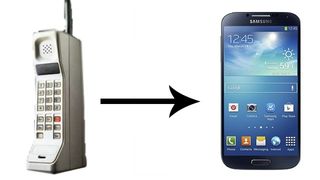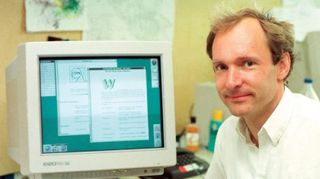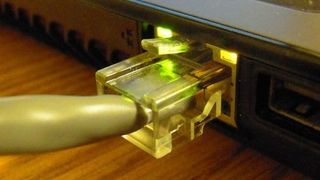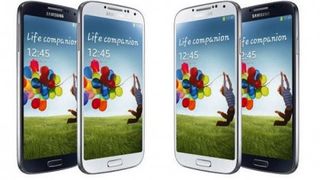22 years of the web, from Sir Tim Berners-Lee to the GALAXY S4
Take a stroll through the brief history of the mobile web

The first commercially available mobile phone was the Motorola DynaTAC, launched almost 30 years ago way back in 1984. Offering a whopping 30 minutes of talk time, a tiny LED screen for dialing, and a memory for a whole 30 numbers, it was barely a phone – and certainly stretched the definition of portable.

1991 – First website put online
Although precursors to the internet (most notably the US Department of Defenses's ARPANET) have been around since the 1960s, the first website was put online on the 6 August 1991.

The site, built by Sir Tim Berners-Lee, the dude who had the idea to put HTTP and the domain-name system together to create the internet, was http://info.cern.ch. The dinky little web page was hosted on a NeXT computer in CERN, with a 25 MHz single-core processor.
By comparison, the GALAXY S4 packs a 1.9 GHz Quad-Core processor (and weighs about 50 times less!).
1996 – First mobile web

The first 'mobile web' access was, somewhat surprisingly, in Finland in 1996. The Nokia Communicator 9000 was the device of choice – but it wasn't a communicator a la Star Trek. Rather, it was a heavy, slow device, with a whole 8MB of RAM. That's about two GIFs, in today's terms!
However, with incredibly high prices and speed that makes dial-up look like a drag racer, mobile web didn't take off until Japan in 1999, with an outdated standard called i-mode. Needless to say, no one really used it for anything bar checking the stock market.
2001 – Broadband launched in the UK

Of course, mobile web wouldn't be anything without broadband. Back in 1999, only one in five households had internet access – and for good reason. Dial-up was torturously slow, as anyone who's ever had a picture load row-by-row knows.
Get daily insight, inspiration and deals in your inbox
Get the hottest deals available in your inbox plus news, reviews, opinion, analysis and more from the TechRadar team.
Broadband, introduced to the UK in 2001, changed all that. With connection speeds actually managing to get over a megabit, web pages with text, pictures and even video (!) became possible. As with all things tech, it's shrunk with time – broadband modems have gone from giant boxes to tiny circuits crammed into handsets like the GALAXY S4.
2003 – Wi-Fi takes over

Although mobile internet was slowly creeping into our lives, it was the standardisation of short-range wireless that made so much of modern technology possible.
The Wi-Fi standard was properly created with the founding of the Wi-Fi Alliance in 1999, which certifies and enforces the 802.11 wireless standard. With a common channel for everyone to play nice on, Wi-Fi quickly spread, until it was commonly found in routers and laptops from 2003 onwards.
1999–2004 – The era of WAP and GPRS
WAP, more properly known as Wireless Application Protocol, was the medium by which old phones could transmit data over the ancient 2G network.
That 2G network is what we know as GPRS. Essentially, WAP is like a toned-down version of the full-fat internet, and GPRS is like a toned-down version of dial-up. Yes, it's that slow. GPRS and WAP were the standard until 3G rolled in around 2005.
2003 - 2009 – Roll on 3G
The next major innovation in mobile web was 3G, which saw the first properly useful mobile data speeds.
3G was first introduced to the UK in 2003, with five major network operators rolling out 3G networks. However, despite the much faster data speeds – a theoretical 2 megabits per second – it took until 2009 for the majority of smartphones in use to be on the 3G bandwagon.
2008 – The first Android phone launched

2008 saw a tremendous leap forwards for the smartphone. The T-Mobile G1, as it was known, had a 3.2-inch 320x480 pixel screen, with a fairly pitiful 528 MHz ARM processor.
Nonetheless, the open-source Android software set the stage for the rise of Samsung's award-winning GALAXY range.
2012 – The year of 4G

Last year saw significant milestones for mobile web. In addition to the launch of devices like the Samsung GALAXY SIII and GALAXY Note II, the UK saw its first (long-awaited) 4G LTE network launched.
Run by EE, the airwaves trembled with speeds of up to 40Mbps, about eight-times faster than the average home broadband. Sadly, only 500,000 lucky people have opted for 4G LTE so far – though with all the major networks set to launch 4G LTE networks later this year, you can expect that number to shoot right through the roof.
Current internet-capable devices are a whole generation on from those of five years ago. The GALAXY S4 has a 1.9 GHz Quad-Core processor and a 5-inch Full HD Super AMOLED screen with more pixels than your eyes can see, not to mention a screen that you don't even have to touch to use, thanks to the GALAXY S4's Air Gesture feature.
The future
Given the changes we've seen in just the last few years, it looks like we're in for a corker of a decade. There are already talks of 'advanced' 4G being rolled out in South Korea, with speeds upwards of 200Mbps – at that rate, you'd be able to download an HD video to your handset in less than a minute.
On the hardware front, experimentation with new materials such as flexible glass, plus advances in battery technology, are looking promising… Who knows what the next GALAXY will look like?
